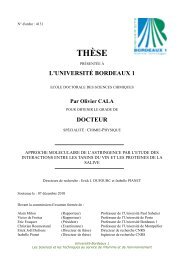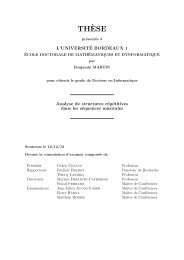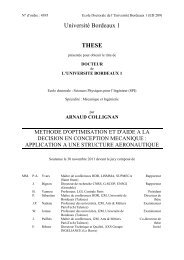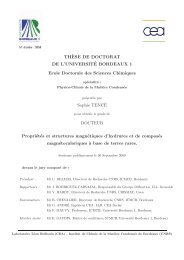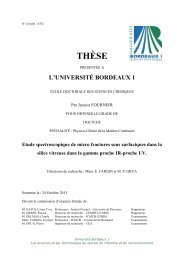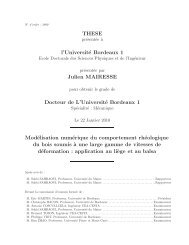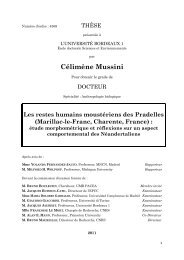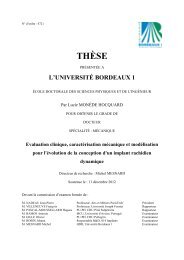de la structure à la croissance cellulaire - Université Bordeaux 1
de la structure à la croissance cellulaire - Université Bordeaux 1
de la structure à la croissance cellulaire - Université Bordeaux 1
Create successful ePaper yourself
Turn your PDF publications into a flip-book with our unique Google optimized e-Paper software.
108 M. Bourdon et al.<br />
randomly-oriented cell divisions occur for longer periods up to 10–18 days postanthesis<br />
(Gil<strong>la</strong>spy et al. 1993; Tanksley 2004). Moreover, two different modified<br />
genetic backgrounds affect cell divisions in tomato pericarp, excluding cell-<strong>la</strong>yer<br />
forming divisions (Cong et al. 2002; Jones et al. 2002). Commonly, tissues closest<br />
to the ovules (e.g., p<strong>la</strong>centa in tomato or fruit surface in strawberry) cease division<br />
earlier than other tissues (Coombe 1976). All these data indicate spatially and<br />
temporally complex regu<strong>la</strong>tion of cell divisions in growing fruit.<br />
After anthesis, the locu<strong>la</strong>r cavities in fruit are usually filled as a result of intense<br />
cell division activity from one or more of the locule surface areas (e.g., p<strong>la</strong>centa in<br />
tomato, septum in banana and grape, endo<strong>de</strong>rmis in banana and orange, and seed<br />
aril in lychee). Cell expansion then contributes to the filling of the locule, which<br />
behaves in concert with the neighboring flesh to form fruit pulp or, as in tomato, to<br />
form a jelly-like tissue with distinct properties from the pericarp (Coombe 1976).<br />
In conclusion, the fruit as a whole is composed of cells, which were present at<br />
anthesis and of newly formed cells during fruit growth. The ratio between both kinds<br />
of cells is a function of the number of doublings at these two phases. After anthesis,<br />
80–97% of fruit cells in apple, strawberry, peach, apricot and tomato are produced,<br />
whereas ca. 70% of fruit cells are formed before anthesis in cucumber and blueberry<br />
(Cano-Medrano and Darnell 1997). The modu<strong>la</strong>tion of cell division in fruit either preor<br />
post-anthesis has repeatedly been associated with strong variations in fruit size.<br />
As an illustration, strong differences in overall anticlinal, but not periclinal, cell<br />
division in the pericarp are associated with varying levels of fw2.2 transcripts<br />
corresponding to the major quantitative trait locus (QTL) for tomato fruit size,<br />
which accounts for as much as a 30% difference in fruit fresh weight between<br />
small-fruited and <strong>la</strong>rge-fruited tomatoes (Cong et al. 2002; Liu et al. 2003).<br />
2.4 Cell Expansion During Fruit Growth<br />
In eukaryotic cells, cell en<strong>la</strong>rgement results from two processes: cell growth by<br />
increase in cytop<strong>la</strong>smic volume and cell expansion through vacuo<strong>la</strong>tion. Cell<br />
growth by cytop<strong>la</strong>smic volume increase may occur in all types of cells and<br />
is responsible for mo<strong>de</strong>rate increases in cell volume, by less than tenfold<br />
(Sugimoto-Shirasu and Roberts 2003). Cell expansion through vacuo<strong>la</strong>tion is a<br />
specific property of p<strong>la</strong>nt cells because of their <strong>la</strong>rge vacuo<strong>la</strong>r compartment, and<br />
it leads to an increase in cell volume by more than one hundredfold (Sugimoto-<br />
Shirasu and Roberts 2003). Cell expansion through vacuo<strong>la</strong>tion typically starts in<br />
young organs, once cells have stop dividing, exit the cell cycle, and differentiate.<br />
Some of the <strong>la</strong>rgest cells found in p<strong>la</strong>nts occur in the flesh of ripe fruit, with cell<br />
length between 150 and 700 mm, and in some cases more than 1 mm. The volume of<br />
cells in ovary wall is only ca. 10 3 –10 2 nL at anthesis whereas it is in the range of<br />
1–10 nL, up to 100 nL in mature fruit (Coombe 1976). Because cell volume may be<br />
increased by 10 2 –10 4 times during the growth of fleshy fruit, this phenomenon



